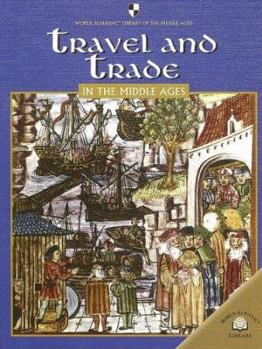Travel and Trade in the Middle Ages
(Part of the World Almanac Library of the Middle Ages Series)
Select Format
Select Condition 
Book Overview
The Middle Ages, from AD 500-1500, were once described as dark and stagnant--a thousand years without a bath. Now, the Middle Ages are celebrated as a time of immense social change, of outstanding achievements in art and science, and of deep spirituality. The World Almanac Library of the Middle Ages uses primary sources and full-color reproductions of medieval manuscripts and artwork to bring this rich tapestry to life. Students will be introduced to unforgettable characters, from valiant knights to reclusive monks, and from kings and popes struggling for supremacy to entire villages fighting to survive the plague. Time lines and focus boxes enhance the text and help give students a deeper understanding and appreciation of this fascinating period of world history.
Format:Library Binding
Language:English
ISBN:0836858999
ISBN13:9780836858990
Release Date:December 2005
Publisher:Gareth Stevens Publishing
Length:48 Pages
Weight:0.95 lbs.
Dimensions:0.4" x 8.0" x 10.2"
Age Range:10 to 13 years
Grade Range:Grades 5 to 8
Customer Reviews
1 rating
How to get a B- on an A+ research paper
Published by Thriftbooks.com User , 18 years ago
Fiona MacDonald has done her usual wonderful job of presenting historical material in a balanced and interesting way to middle school students. The text of "Travel and Trade in the Middle Ages" is engaging from the first page to the last, and the numerous illustrations have been very carefully chosen. This is a real winner - until you get to page 37. Perhaps the publisher changed editors at the very last minute. Maybe the book was late to the printers. At any rate, on page 37 a caption to an illustration describes the piece as containing a skull to "remind both of their eventual deaths." A nice flight of fancy - but there is no skull in the picture, just a little white dog asleep on a cushion at his mistress' feet. On page 40 you will find another lovely old illustration, together with a caption telling the reader that it shows a "jeweler, a herbalist and a baker (left to right)." Perhaps that is the case, if you eliminate the butcher very clearly carving up a pig, but the far right portion of the picture shows only a man with his hand in a bowl. Nothing of any sort at all to indicate a baker. One particularly nice feature of "Travel and Trade..." is the inclusion of short quotations from Middle Ages authors every couple of pages, duly footnoted and cited in the back of the book. Wonderful - until page 40. The footnote to the quotation of page 40 is numbered 21. So is the quotation on page 38. The last two quotations are noted as 24 and 25; 22 and 23 are missing from the text. The bibliography, however, contains citations for 22 and 23, but not 24 and 25 - and of course only one 21, leaving the reader to guess which quotation 21 it belongs to. I am left to conclude only that the person responsible for editing this book suddenly went blind, turning what might have been an A+ book into one that deserves only a B-.






